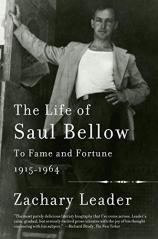The Life of Saul Bellow: To Fame and Fortune, 1915-1964
Review
The Life of Saul Bellow: To Fame and Fortune, 1915-1964
I like to imagine that when Zachary Leader published his biography of English novelist Kingsley Amis in 2006 --- appropriately, and quite literally, titled THE LIFE OF KINGSLEY AMIS --- potential readers took one look at the volume, immediately about-faced, and broke into a dead run. The 1000-plus-page monster of a work provided an exhaustive portrayal of Amis, who, in the United States, is likely better known as the father of fellow English novelist Martin Amis than a writer in his own right. Those potential readers will be pleased to know that Leader’s latest volume, THE LIFE OF SAUL BELLOW: To Fame and Fortune 1915-1964 (sensing a pattern here?), is only 650 pages --- provided, of course, that you’re the sort of reader who ignores the additional 115 pages of endnotes and the promise of a second volume covering the remaining 40 years of Saul Bellow’s life. It may also please those readers that Leader’s first volume is a masterpiece, and practically a free seminar in the art of the life study.
To be fair, Bellow gives Leader quite a lot to work with. The “most decorated writer in American history, the winner, among other awards, of the Nobel Prize for Literature, three National Book Awards, the Pulitzer Prize,” and on, Bellow’s personal life was as juicy as his fiction --- the latter, unsurprisingly, having borrowed a great deal from the former. “In some novels and stories,” Leader writes, “people he knew, including friends and relations, were not only bound to see themselves depicted but they were meant to do so.” He used his fiction to praise and paint, to expose and condemn, and in the end, even the author questioned his own methods. On his deathbed, Bellow turned to a friend and asked, “Was I a man” --- a mensch, a worthy human being, a man of character --- “or was I a jerk?”
"Masterfully tracing Bellow’s growth from precocious youth to his eventual status in the 1960s as perhaps America’s greatest living novelist, Leader fleshes out even the smallest details, yet all of these seem carefully chosen, deliberately unpacked..."
Like Bellow biographers before him, Leader attempts an answer. Unlike them, he had the advantage of writing this biography after his subject’s death, and thus the freedom to conduct his research and form an opinion without Bellow’s interventions. When mentioning the struggles of his predecessors, Leader describes Bellow as “wary,” “prickly” and “evasive,” and his effect on previous biographer James Atlas as enough to help “produce the note of resentment some have heard” in his book.
These stories may have led a lesser biographer to vote “jerk” from the start, but Leader’s assessment is remarkably level-headed and, in the end, all about the art. From his introduction: “What makes Bellow a bird not an ornithologist is his ability to transform facts or experiences into great literature, thus changing them. This view of art as new creation is often invoked as a defense against the accusations of slander or defamation. Art can be viewed in other ways; for example, as imitation or mimesis, the oldest of aesthetic aims and pleasures. Mimesis, too, involves touching experiences or facts with the imagination. Bellow was a famed noticer and his novels and stories are packed with things perfectly seen.”
Leader’s noticing, too, deserves commendation. An academic’s biography of a fiercely intellectual author (also an academic) could easily go the way of… well, the academic, and many a plodding tome has been written detailing the life of a difficult 20th-century white male American novelist. Thankfully, this book, despite its length and subject, is anything but plodding. Masterfully tracing Bellow’s growth from precocious youth to his eventual status in the 1960s as perhaps America’s greatest living novelist, Leader fleshes out even the smallest details, yet all of these seem carefully chosen, deliberately unpacked: Bellow’s infancy in Canada; his childhood and adolescence in Chicago (no, he was not “Chicago-born”); his Russian-, Jewish-, immigrant-raised upbringing; his many marriages, flings and affairs, friendships and fallouts; his progressive yet often problematic politics; and, of course, the writing.
The moment that serves as the climax of Leader’s book amounts to the springboard moment for Bellow’s writing life. Bellow was in Paris, and it was 1949. He had written two books by then, but writing hadn’t been easy --- his first story was published only after he had turned 25, and he would not succeed in making a living from writing alone (much more common then than now, I’m told) until near the end of this volume. Walking down the street one afternoon, sustained only by grant money and lamenting his state, he walked by some Parisian municipal workers cleaning out a hydrant.
“I suppose a psychiatrist would say that this was some kind of hydrotherapy --- the flowing water freeing me from the caked burden of depression that had formed on my soul,” Bellow told his friend and fellow Jewish-American mega-novelist, Philip Roth, in a New Yorker interview in 2005. “But it wasn’t so much the water as the sunny iridescence…. I remember saying to myself, ‘Well, why not take a short break and have at least as much freedom of movement as this running water?’”
That freedom resulted in THE ADVENTURES OF AUGIE MARCH, an oft-cited candidate for that ever-elusive white whale, the “Great American Novel.” For Leader, Bellow proves quite the catch himself: a Great American Author with a life as big as his work. Lucky for us, we have a whole second volume to live it alongside him.
Reviewed by John Maher on May 15, 2015
The Life of Saul Bellow: To Fame and Fortune, 1915-1964
- Publication Date: November 15, 2016
- Genres: Biography, History, Nonfiction
- Paperback: 864 pages
- Publisher: Vintage
- ISBN-10: 030738893X
- ISBN-13: 9780307388933





